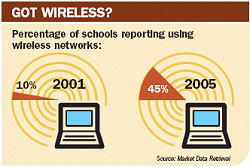Classroom Collaborators
##AUTHORSPLIT##<--->
Wireless connectivity is providing a level of flexibility for students and teachers, changingthe learning environment in ways that in some cases has to be seen to be believed.

FOCUSED: Experts say that wireless
technology's way of engaging students
in the learning process supersedes its
bottom-line benefits.
JOHN CHAMBERS, CEO of San Jose, CA-based computer networking giant Cisco Systems, paced the main stage in San Francisco's Moscone Conference Center, admonishing the members of his audience like a Southern preacher, warning them to prepare themselvesfor a revolution.
"Do you ever watch your children doing their homework?" he asked. "They're listening to music, instant messaging, and chatting on the phone at the same time. These aren't distractions you're seeing, but new forms of collaboration. You may not like it. You may say, ‘That's not for me.' But believe me, that'll be you in five years. You will change your form of collaboration, in your business and in your personal interactions....Collaboration is the next frontier. It will be enabled by different concepts and different devices, but it will be about the power of the human network in ways we are just beginning to understand."
Chambers was speaking to an audience of businesspeople and technologists at a conference last fall, but according to Ben Gibson, director of marketing for Cisco's wireless and mobility solutions group, the future he described will be enabled in no small part by wireless connectivity technologies that are being pioneered today in K-12 school districts around the country.
"Schools are a natural environment for wireless," Gibson says. "Wherever you're looking to promote collaboration and more easily accessible information, wireless is a natural fit."
Easy access to information and more flexible forms of collaboration were at the top of the wishlist at Kent School District, outside Seattle, when it first began pursuing a wireless strategy back in 1999. That was the year Apple Computer offered its first AirPort wireless local area network (WLAN) system. By 2001, Kent had provided one AirPort-based wireless laptop cart for each of its schools, and it has been expanding its wireless capabilities ever since. Last year the district launched a pilot program that equipped Mill Creek Middle School with complete wireless capabilities. The pilot is now a full-fledged program, and the district is planning to wirelessly enable all of its 40 schools while providing each student with a laptop.
Kent's wireless strategy, though closely linked to the 1-to-1 computing initiative, isn't about providing additional network capacity, or even cutting costs. A few years ago, the district completed a major building infrastructure upgrade, wiring each of its schools to the latest standards, with 10 network drops in each classroom. What wireless adds to the district's already advanced network, explains Thuan Nguyen, Kent's director of operations and technical services, is a level of flexibility in the instructional process, and support for the same kind of collaboration John Chambers was evangelizing.
You won’t see all the kids sitting in rows, facing the front of the room,listening to the teachers. They spend most of the day in small groupsscattered around the classroom and out in the hallway.
—Thuan Nguyen, Kent School District
"You almost have to come to one of these classrooms and see how the students are using the technology to really understand its impact," Nguyen says. "You won't see all the kids sitting in rows, facing the front of the room, listening to the teachers. They spend most of the day in small groups scattered around the classroom and out in the hallway. Wireless is a tool that gives them the flexibility to learn their way, and it's quickly becoming a necessity in the schools."
Kent has standardized its wireless network on Cisco's Unified Wireless Architecture service, Nguyen says. The system is running Cisco 6500s—powerful switches to control network access—with 10-gigabit backbones connecting some of the schools.
Cisco has been providing technologies for WLANs in the education market since wireless technology emerged. Colleges and universities were among the earliest adopters, Gibson says, but K-12 school districts were a close second. Now some districts seem to be blazing a veritable wireless trail for the communities at large.
One of the largest WLANs in the world was implemented by Virginia's Fairfax County Public Schools. Fairfax County is the biggest school district in the state and the 12th largest in the country. Several years ago, the district set out to"break down classroom walls" by providing wireless broadbandaccess to every classroom, says Fairfax County AssistantSuperintendent and CEO Maribeth Luftglass."Our community is very high-tech," she says. "There's anexpectation here that everything will be online. And wirelessconnectivity goes along with that."
Today, Fairfax operates a network of 7,500 Cisco Aironet 1100 Series access points deployed throughout the district's 242 schools and other facilities. The district manages its WLAN with the AirWave Management Platform, a software application installed on multiple servers in the district's network operations center.
WLAN technology has also emerged as an important enabling technology that lets school districts extend their existing networks into areas where hardwiring would be expensive or difficult. At the Kent School District, for example, wireless made it possible to put computers into environments with infrastructure-related restrictions. "We're talking about buildings that were so old they barely had power," Nguyen says, "sites where it would simply cost too much to run networking cables. Wireless eliminated that restriction."
 Nguyen believes wireless is becoming an essential educational technology. And it looks like he's not alone: According to Market Data Retrieval's report,"The K-12 Technology Review 2005," wireless is spreadingfast among school districts. In 2001, when MDR researchersfirst asked schools about the availability of wireless networks,just 10 percent reported using any wireless network system.In 2005, the researchers found 45 percent reported usingwireless networks. "The growth is evident at all school types,"the researchers wrote, "although senior high schools (54 percent)are more likely to have wireless networks than elementaryschools (40 percent)."
Nguyen believes wireless is becoming an essential educational technology. And it looks like he's not alone: According to Market Data Retrieval's report,"The K-12 Technology Review 2005," wireless is spreadingfast among school districts. In 2001, when MDR researchersfirst asked schools about the availability of wireless networks,just 10 percent reported using any wireless network system.In 2005, the researchers found 45 percent reported usingwireless networks. "The growth is evident at all school types,"the researchers wrote, "although senior high schools (54 percent)are more likely to have wireless networks than elementaryschools (40 percent)."
Nguyen insists that the value of wireless as a learning tool and an enabler of new forms of collaboration transcends any bottom-line benefits it might provide. "During our pilot program, I stopped into a classroom to observe what was happening," Nguyen says. "The students were collaborating through their wireless laptops, and one student submitted a document to the teacher related to what they were all working on. The teacher thought it was a great example, and asked the student to stand up and talk about it more. It was only then that she realized the student wasn't in the classroom. She was home sick that day, but still collaborating with her fellow students on the assignment."
John K.Waters is a freelance writer based in Palo Alto, CA.